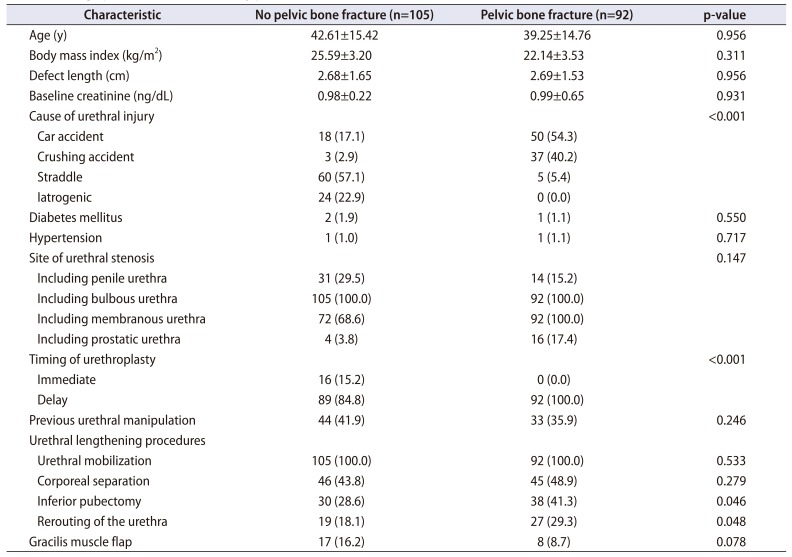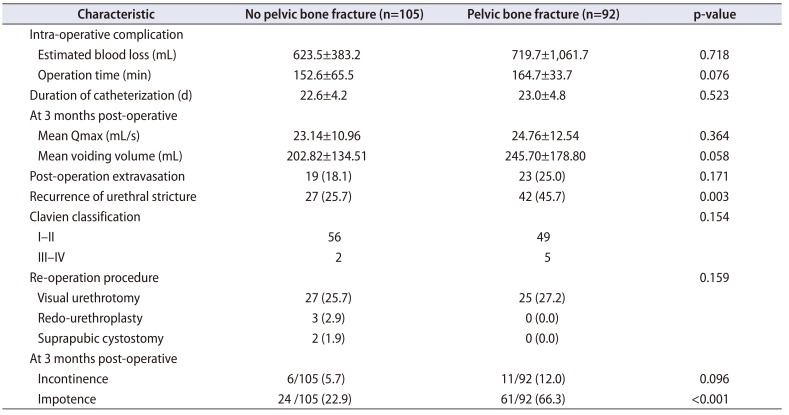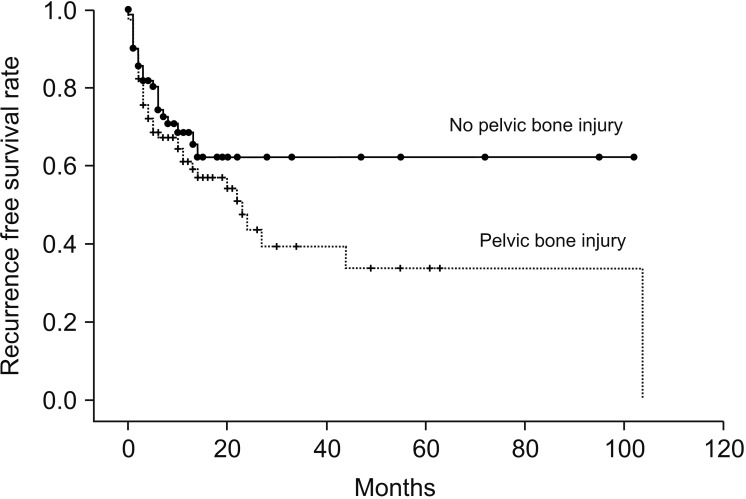1. Min BD, Lee ET, Kim WT, Kim YJ, Yun SJ, Lee SC, et al. Tubal buccal mucosa graft without anastomosis of the proximal urethra for long segment posterior urethral defect repair. Korean J Urol. 2012; 53:737–740. PMID:
23136637.

2. Scarberry K, Bonomo J, Gómez RG. Delayed posterior urethroplasty following pelvic fracture urethral injury: do we have to wait 3 months? Urology. 2018; 116:193–197. PMID:
29545047.

3. Horiguchi A, Shinchi M, Masunaga A, Okubo K, Kawamura K, Ojima K, et al. Primary realignment for pelvic fracture urethral injury is Associated with Prolonged Time to Urethroplasty and Increased Stenosis Complexity. Urology. 2017; 108:184–189. PMID:
28606774.

4. Zou Q, Zhou S, Zhang K, Yang R, Fu Q. The immediate management of pelvic fracture urethral injury-endoscopic realignment or cystostomy? J Urol. 2017; 198:869–874. PMID:
28442385.

5. Mathur R, Aggarwal G, Satsangi B, Khan F, Odiya S. Prognosis of urethral strictures following pelvic fracture urethral distraction defects--a single centre study. Int J Surg. 2011; 9:68–71. PMID:
20887822.

6. Kulkarni SB, Barbagli G, Kulkarni JS, Romano G, Lazzeri M. Posterior urethral stricture after pelvic fracture urethral distraction defects in developing and developed countries, and choice of surgical technique. J Urol. 2010; 183:1049–1054. PMID:
20092843.

7. Kessler TM, Schreiter F, Kralidis G, Heitz M, Olianas R, Fisch M. Long-term results of surgery for urethral stricture: a statistical analysis. J Urol. 2003; 170:840–844. PMID:
12913712.

8. Berger AP, Deibl M, Bartsch G, Steiner H, Varkarakis J, Gozzi C. A comparison of one-stage procedures for post-traumatic urethral stricture repair. BJU Int. 2005; 95:1299–1302. PMID:
15892821.

9. Breyer BN, McAninch JW, Whitson JM, Eisenberg ML, Mehdizadeh JF, Myers JB, Voelzke BB. Multivariate analysis of risk factors for long-term urethroplasty outcome. J Urol. 2010; 183:613–617. PMID:
20018318.

10. Andrich DE, Day AC, Mundy AR. Proposed mechanisms of lower urinary tract injury in fractures of the pelvic ring. BJU Int. 2007; 100:567–573. PMID:
17608826.

11. Gómez RG, Mundy T, Dubey D, El-Kassaby AW, Firdaoessaleh , Kodama R, et al. SIU/ICUD consultation on urethral strictures: pelvic fracture urethral injuries. Urology. 2014; 83(3 Suppl):S48–S58. PMID:
24210734.

12. Koraitim MM, Marzouk ME, Atta MA, Orabi SS. Risk factors and mechanism of urethral injury in pelvic fractures. Br J Urol. 1996; 77:876–880. PMID:
8705225.

13. Koraitim MM, Atta MA, Fattah GA, Ismail HR. Mechanism of continence after repair of post-traumatic posterior urethral strictures. Urology. 2003; 61:287–290. PMID:
12597932.

14. Malavaud B, Mouzin M, Tricoire JL, Gamé X, Rischmann P, Sarramon JP, et al. Evaluation of male sexual function after pelvic trauma by the International Index of Erectile Function. Urology. 2000; 55:842–846. PMID:
10840088.

15. Flynn BJ, Delvecchio FC, Webster GD. Perineal repair of pelvic fracture urethral distraction defects: experience in 120 patients during the last 10 years. J Urol. 2003; 170:1877–1880. PMID:
14532797.

16. Andrich DE, Mundy AR. The nature of urethral injury in cases of pelvic fracture urethral trauma. J Urol. 2001; 165:1492–1495. PMID:
11342903.

17. Andrich DE, Mundy AR. What is the best technique for urethroplasty? Eur Urol. 2008; 54:1031–1041. PMID:
18715692.

18. Meeks JJ, Erickson BA, Granieri MA, Gonzalez CM. Stricture recurrence after urethroplasty: a systematic review. J Urol. 2009; 182:1266–1270. PMID:
19683309.

19. Hosseini J, Tavakkoli Tabassi K. Surgical repair of posterior urethral defects: review of literature and presentation of experiences. Urol J. 2008; 5:215–222. PMID:
19101893.
20. Rourke KF, Jordan GH. Primary urethral reconstruction: the cost minimized approach to the bulbous urethral stricture. J Urol. 2005; 173:1206–1210. PMID:
15758749.

21. Roehrborn CG, McConnell JD. Analysis of factors contributing to success or failure of 1-stage urethroplasty for urethral stricture disease. J Urol. 1994; 151:869–874. PMID:
8126813.

22. Koraitim MM. Failed posterior urethroplasty: lessons learned. Urology. 2003; 62:719–722. PMID:
14550450.

23. Mundy AR. Transperineal bulbo-prostatic anastomotic urethroplasty. World J Urol. 1998; 16:164–170. PMID:
9666538.

24. Cavalcanti AG, Yucel S, Deng DY, McAninch JW, Baskin LS. The distribution of neuronal and inducible nitric oxide synthase in urethral stricture formation. J Urol. 2004; 171:1943–1947. PMID:
15076317.

25. Cavalcanti AG, Costa WS, Baskin LS, McAninch JA, Sampaio FJ. A morphometric analysis of bulbar urethral strictures. BJU Int. 2007; 100:397–402. PMID:
17617144.

26. Wadhwa SN, Chahal R, Hemal AK, Gupta NP, Dogra PN, Seth A. Management of obliterative posttraumatic posterior urethral strictures after failed initial urethroplasty. J Urol. 1998; 159:1898–1902. PMID:
9598483.

27. Anger JT, Sherman ND, Dielubanza E, Webster GD, Hegarty PK. Erectile function after posterior urethroplasty for pelvic fracture-urethral distraction defect injuries. BJU Int. 2009; 104:1126–1129. PMID:
19426188.

28. Shenfeld OZ, Kiselgorf D, Gofrit ON, Verstandig AG, Landau EH, Pode D, et al. The incidence and causes of erectile dysfunction after pelvic fractures associated with posterior urethral disruption. J Urol. 2003; 169:2173–2176. PMID:
12771742.

29. Harwood PJ, Grotz M, Eardley I, Giannoudis PV. Erectile dysfunction after fracture of the pelvis. J Bone Joint Surg Br. 2005; 87:281–290. PMID:
15773631.

30. Koraitim MM. Predictors of erectile dysfunction post pelvic fracture urethral injuries: a multivariate analysis. Urology. 2013; 81:1081–1085. PMID:
23465164.








 PDF
PDF ePub
ePub Citation
Citation Print
Print




 XML Download
XML Download